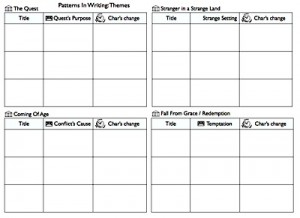We’re continuing our journey through a writing unit focused on the patterns of great writing. This lesson, number three in the series, covers commonly used themes. These lessons assume an understanding of the depth and complexity icons as well as the content imperatives.
Objective
Students will categorize stories according to a repeating pattern of themes using a variety of films, novels, short stories, and video games.
Hook
Ask students if they have ever heard of a story where someone begins as a good person, is corrupted, and then returns to good at the end? Solicit examples of stories with this patter. Allow a lot of thinking time as your students make connections.
After you’ve some examples, explain that these stories all share a similar “big idea” or theme. In particular, this theme is known as “a fall from grace” and “redemption.”
There are only a few themes authors choose from and they are repeated throughout history. This is another example of the generalization “structure increases creativity” in writing. Authors pick a theme and then build creatively around it.
Instruction
Define “Theme”
My 6th graders are fluent with the idea of an “author’s message,” so I don’t spend too much time definining “theme.” The introductory hook is typically enough. With younger students, you may need to introduce this concept (perhaps as its own lesson). Explain that a theme is the big idea that the author is exploring in his writing. It is not stated directly in the writing, but instead we must infer the theme based on evidence.
Let’s look at some common themes that authors use (as you are defining these terms, be sure to allow student participation. They will make connections to stories that you may be unfamiliar with. Encourage this since they are constructing meanining):
Fall From Grace/Redemption
Definition: A character begins as a hero or otherwise “good” person. Through some event, the character becomes “bad.” This is the fall from grace. The character then earns back their good standing through selfless action. This is the redemption. It’s possible, of course, to have a story about a fall from grace with no redemption or redemption without a fall from grace.
Essential characteristics:
- The protagonist begins heroically.
- A selfish act destroys the protagonist’s reputation.
- The protagonist returns to the hero status through selfless acts.
Examples:
- Anakin Skywalker (Star Wars)
- Brutus (Julius Caesar) – no redemption
- Scrooge (A Christmas Carol) – no fall from grace
The Quest or The Journey
Definition: The protagonist is on a mission to find a place, a person, or an item. During the journey, the main character experiences a change over time.
Essential characteristics:
- Character begins humbly
- Character acquires comrades
- Character changes throughout story
- The quest is less important than the final growth
Examples include:
- The Lord Of The Rings – Frodo must reach Mordor to destroy the ring.
- A Wrinkle In Time – Meg must find her father
- The Wizard Of Oz – Dorothy must reach the Emerald City so she can return home.
Coming of Age/Loss of Innocence
Definition A character grows up and loses their childish ways. This may mean taking on new responsibilities or realizing that something isn’t important. The loss of innocence theme has a more negative view of this transformation while a coming of age story is positive.
Essential Characteristics
- Character begins as a young person
- Character clashes with authority (teacher, parent, older sibling)
- Character goes through a conflict which changes their point of view
- Character understands the point of view of the authority
- The change can be good or bad (loss of innocence)
Examples include:
- Hatchet
- Where The Red Fern Grows
- To Kill A Mockingbird
- Grandfather’s Journey
- Lord of the Flies
Stranger In A Strange Land or Alienation
DefinitionA character is put in a place in which he feels alone and out of place. During this time, the character learns about himself and grows. He may also helps those around him grow as well. Essential characteristics:
- Character is out of place – strange setting, strange characters
- Character learns from his strange surroundings
- The other characters may learn from the main character
Examples include:
- E.T.
- Harry Potter
- Wizard of Oz
Guided Practice
Students now enter groups of four and are presented with a list of well-known stories and films. They categorize these stories based on their themes. I give them a list of stories and a literary theme worksheet:
Naturally, you know which stories will work best with your class. They sort these into theme categories, giving an explanation of how the story fits with the theme. This would then be shared out and we would note any differences among groups. It is reasonable that one story could fit under multiple themes.
Independent Practice
I give students an assortment of settings – pictures taken from Flickr’s most interesting photos of the week. Students pick one setting and a plot summary using one of the themes we introduces. This plot should follow the dramatic structure presented in the previous lesson.
This lesson has led to some incredible stories of redemption set on a volcano :)

